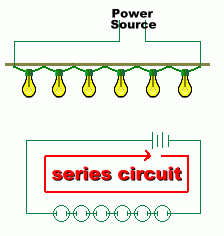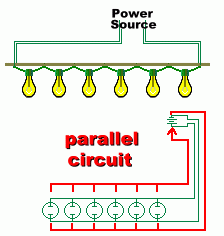|
Amazingly, very few of the bulbs anywhere were burnt out ... dead ones must be replaced every day! The large arrays of light bulbs of course immediately suggested the difference between series and parallel circuits, and why all the lights on a ride don't go off if one light burns out. Let's look at the difference. 
Here's a simple series circuit, made from a single wire, where the electricity can flow in a complete path ... from the power source, around the wire, and back to the source. In order for this circuit to function, the path that the electicity follows must be unbroken. This means that if a single bulb burns out, the circuit will be broken, and the entire string of bulbs will go out. Clearly, a series circuit is not very useful if you have more than one object that needs electricity. When a bulb blows, you would have to test every single bulb on the circuit to find the one that is broken.  Here's the way most circuits are set up. This is called a parallel circuit. You probably know that most electrical wiring is composed of a double strand of wire. This creates a complete circuit path that can follow any one of the branches, or all of them. The electricity flows through each bulb on a separate branch of the circuit. In a parallel circuit, the bubs are on separate paths, that look like rungs of a ladder. If one bulb blows, the electricity can't flow through that branch of the circuit. But it can still flow through all the other branches! The result is that a dead bulb will not cause the entire circuit to stop working, and the one bulb that isn't receiving electricity can be easily identified and replaced. |